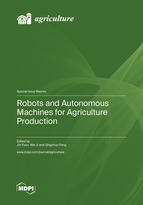Robots and Autonomous Machines for Agriculture Production
A special issue of Agriculture (ISSN 2077-0472). This special issue belongs to the section "Agricultural Technology".
Deadline for manuscript submissions: closed (20 January 2023) | Viewed by 73201
Special Issue Editors
Interests: selective harvesting; robotic manipulator; novel robotic applications; machine vision
Special Issues, Collections and Topics in MDPI journals
Interests: picking robot; robotic manipulator; machine vision
Interests: agricultural robotics control; compliant operation; intelligence sensing technology; deep reinforcement learning
Special Issues, Collections and Topics in MDPI journals
Special Issue Information
The growth of the global population has put agricultural production in a difficult position. The drastic rise in population requires doubling agricultural production to meet the increasing demand. People have to produce more food to satiate the dietary needs of the billions of people in the world. Meanwhile, the population is aging and the level of agricultural labor is reducing, with agricultural production costs rising accordingly. Crippling labor shortages threaten the survival of farmers in many countries. This need has caused farmers to turn to robots and autonomous machines for the future. With the help of robots and autonomous machines, farmers can be freed from heavy labor and improve their management level and working efficiency. The applications of robots and autonomous machines have gradually penetrated all chains of agricultural production. They can help to mitigate labor shortages by reducing our reliance on manpower and can improve agricultural productivity to support sustainable economic development and growth.
Robots and autonomous machines represent a high level of application of automation to agriculture, which is based on a precise and resource-efficient approach that attempts to sustainably achieve a higher efficiency in the production of agricultural goods with an increased quality. The benefits of robots and autonomous machines in agriculture involve increasing crop yields and quality while reducing the environmental impact. Recently, due to the improvement of the performance of artificial intelligence, precision farming, and advanced control, they have been widely used in a variety of agricultural applications, including the management of seedlings, disease detection, crop monitoring and protection, yield estimation, and crop harvesting. Reacting technologies based on agricultural robots and autonomous machines are separate but closely related sectors that cover the process of applying automatic control and robotic platforms at all levels of agricultural production. This is also one of the mainstream research directions of current researchers.
In a robot or autonomous system, because of the complexity of the operation environment of agriculture production, sensing and control in agriculture are especially difficult. The open robot system has a good expansibility, versatility, and flexible operation ability. The establishment of an agricultural robot control system in line with the open definition and characteristics can ensure reliability and real-time control. These challenges (and others) related to the application of robots and autonomous machines for agricultural production are expected to be covered in research and review manuscripts submitted to this Special Issue. The purpose of this Special Issue is to explore the various methods used for dealing with general problems in robots and autonomous machines applied for agriculture production. We invite the submission of studies focused on applications in this topic.
Dr. Jin Yuan
Dr. Wei Ji
Dr. Qingchun Feng
Guest Editors
Manuscript Submission Information
Manuscripts should be submitted online at www.mdpi.com by registering and logging in to this website. Once you are registered, click here to go to the submission form. Manuscripts can be submitted until the deadline. All submissions that pass pre-check are peer-reviewed. Accepted papers will be published continuously in the journal (as soon as accepted) and will be listed together on the special issue website. Research articles, review articles as well as short communications are invited. For planned papers, a title and short abstract (about 100 words) can be sent to the Editorial Office for announcement on this website.
Submitted manuscripts should not have been published previously, nor be under consideration for publication elsewhere (except conference proceedings papers). All manuscripts are thoroughly refereed through a single-blind peer-review process. A guide for authors and other relevant information for submission of manuscripts is available on the Instructions for Authors page. Agriculture is an international peer-reviewed open access monthly journal published by MDPI.
Please visit the Instructions for Authors page before submitting a manuscript. The Article Processing Charge (APC) for publication in this open access journal is 2600 CHF (Swiss Francs). Submitted papers should be well formatted and use good English. Authors may use MDPI's English editing service prior to publication or during author revisions.
Keywords
- agricultural automation
- novel robotic applications
- selective harvesting
- robotic manipulator
- sensing and autonomous control
- big-data and information analytics
- machine vision
- motion planning
- intelligent decision
- multimodal navigation
- localization and mapping
- human–robot interaction
- multi-robot systems and collaboration operation








